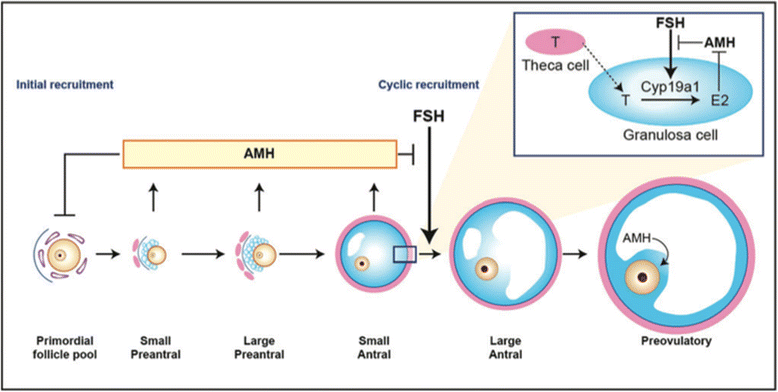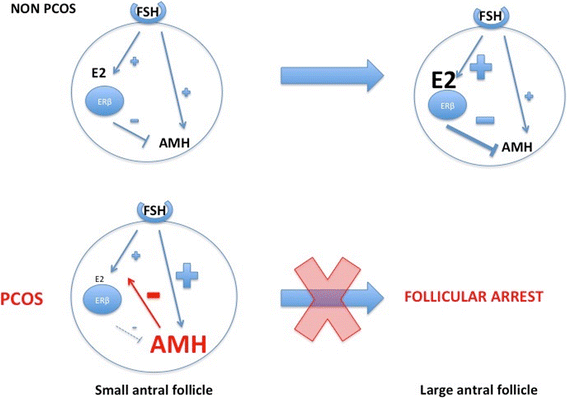Role of Anti-Müllerian Hormone in pathophysiology, diagnosis and treatment of Polycystic Ovary Syndrome: a review
- PMID: 26691645
- PMCID: PMC4687350
- DOI: 10.1186/s12958-015-0134-9
Role of Anti-Müllerian Hormone in pathophysiology, diagnosis and treatment of Polycystic Ovary Syndrome: a review
Abstract
Polycystic ovary syndrome (PCOS) is the most common cause of chronic anovulation and hyperandrogenism in young women. Excessive ovarian production of Anti-Müllerian Hormone, secreted by growing follicles in excess, is now considered as an important feature of PCOS. The aim of this review is first to update the current knowledge about the role of AMH in the pathophysiology of PCOS. Then, this review will discuss the improvement that serum AMH assay brings in the diagnosis of PCOS. Last, this review will explain the utility of serum AMH assay in the management of infertility in women with PCOS and its utility as a marker of treatment efficiency on PCOS symptoms. It must be emphasized however that the lack of an international standard for the serum AMH assay, mainly because of technical issues, makes it difficult to define consensual thresholds, and thus impairs the widespread use of this new ovarian marker. Hopefully, this should soon improve.
Figures



Similar articles
-
Accuracy of anti-Müllerian hormone and total follicles count to diagnose polycystic ovary syndrome in reproductive women.Taiwan J Obstet Gynecol. 2018 Aug;57(4):499-506. doi: 10.1016/j.tjog.2018.06.004. Taiwan J Obstet Gynecol. 2018. PMID: 30122568
-
The role of anti-Müllerian hormone in the pathogenesis and pathophysiological characteristics of polycystic ovary syndrome.Eur J Obstet Gynecol Reprod Biol. 2016 Apr;199:82-7. doi: 10.1016/j.ejogrb.2016.01.029. Epub 2016 Feb 10. Eur J Obstet Gynecol Reprod Biol. 2016. PMID: 26914398 Review.
-
The phenotypic diversity in per-follicle anti-Müllerian hormone production in polycystic ovary syndrome.Hum Reprod. 2015 Aug;30(8):1927-33. doi: 10.1093/humrep/dev131. Epub 2015 Jun 4. Hum Reprod. 2015. PMID: 26048913
-
Anti-müllerian hormone in the pathophysiology and diagnosis of polycystic ovarian syndrome.Curr Opin Endocrinol Diabetes Obes. 2018 Dec;25(6):377-384. doi: 10.1097/MED.0000000000000445. Curr Opin Endocrinol Diabetes Obes. 2018. PMID: 30299432 Review.
-
Impact of laparoscopic ovarian drilling on anti-Müllerian hormone levels and ovarian stromal blood flow using three-dimensional power Doppler in women with anovulatory polycystic ovary syndrome.Fertil Steril. 2011 Jun;95(7):2342-6, 2346.e1. doi: 10.1016/j.fertnstert.2011.03.093. Epub 2011 Apr 22. Fertil Steril. 2011. PMID: 21514928
Cited by
-
Shaoyao-Gancao Decoction alleviated hyperandrogenism in a letrozole-induced rat model of polycystic ovary syndrome by inhibition of NF-κB activation.Biosci Rep. 2019 Jan 11;39(1):BSR20181877. doi: 10.1042/BSR20181877. Print 2019 Jan 31. Biosci Rep. 2019. PMID: 30573529 Free PMC article.
-
Developmental Programming: Prenatal Testosterone Excess on Ovarian SF1/DAX1/FOXO3.Reprod Sci. 2020 Jan;27(1):342-354. doi: 10.1007/s43032-019-00029-0. Epub 2020 Jan 1. Reprod Sci. 2020. PMID: 32046386 Free PMC article.
-
Clinical, Biochemical, and Hormonal Associations in Female Patients with Acne: A Study and Literature Review.J Clin Aesthet Dermatol. 2017 Oct;10(10):18-24. Epub 2017 Oct 1. J Clin Aesthet Dermatol. 2017. PMID: 29344316 Free PMC article.
-
The contribution of rare genetic variants to the pathogenesis of polycystic ovary syndrome.Curr Opin Endocr Metab Res. 2020 Jun;12:26-32. doi: 10.1016/j.coemr.2020.02.011. Epub 2020 Apr 3. Curr Opin Endocr Metab Res. 2020. PMID: 32440573 Free PMC article.
-
Polycystic Ovary Syndrome (PCOS), Diagnostic Criteria, and AMH.Asian Pac J Cancer Prev. 2017 Jan 1;18(1):17-21. doi: 10.22034/APJCP.2017.18.1.17. Asian Pac J Cancer Prev. 2017. PMID: 28240001 Free PMC article.
References
-
- Rajpert-De Meyts E, Jorgensen N, Graem N, Muller J, Cate RL, Skakkebaek NE. Expression of anti-Mullerian hormone during normal and pathological gonadal development: association with differentiation of Sertoli and granulosa cells. J Clin Endocrinol Metab. 1999;84(10):3836–44. - PubMed
Publication types
MeSH terms
Substances
LinkOut - more resources
Full Text Sources
Other Literature Sources
Medical

